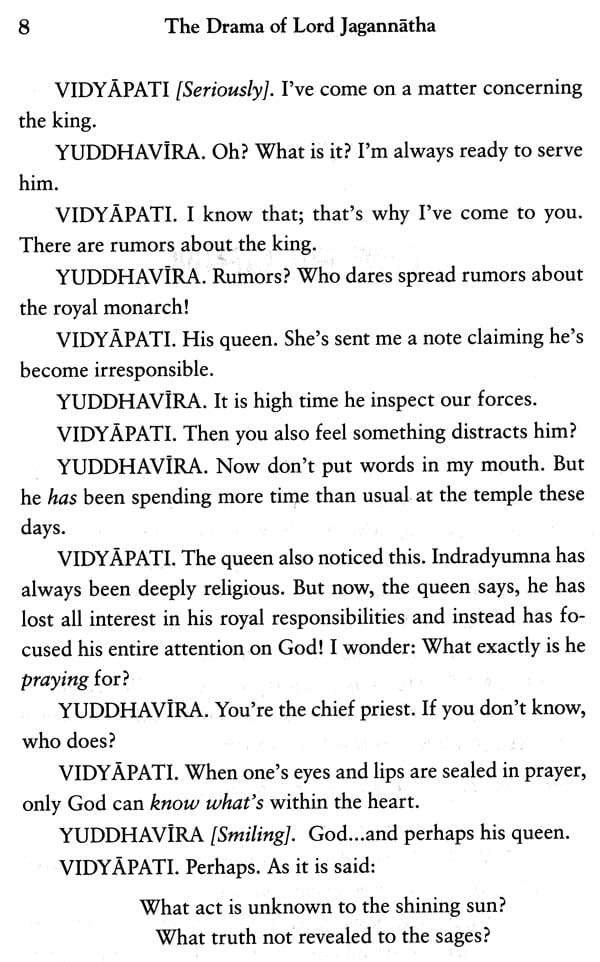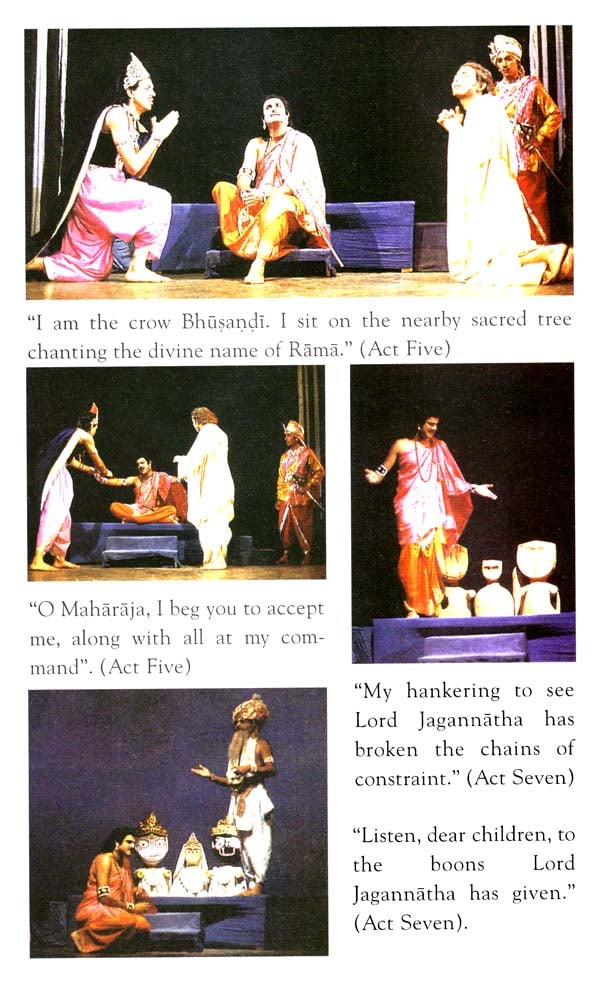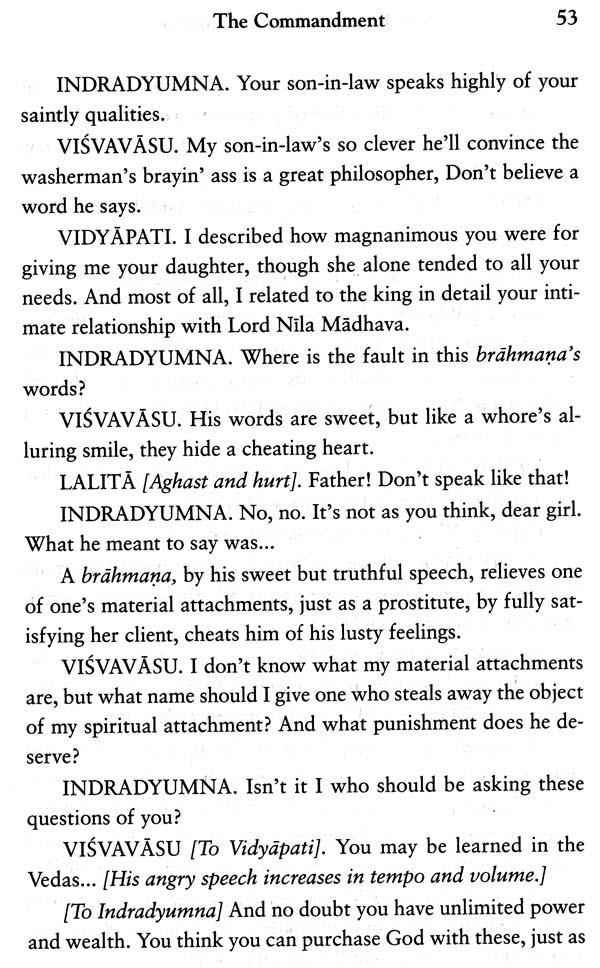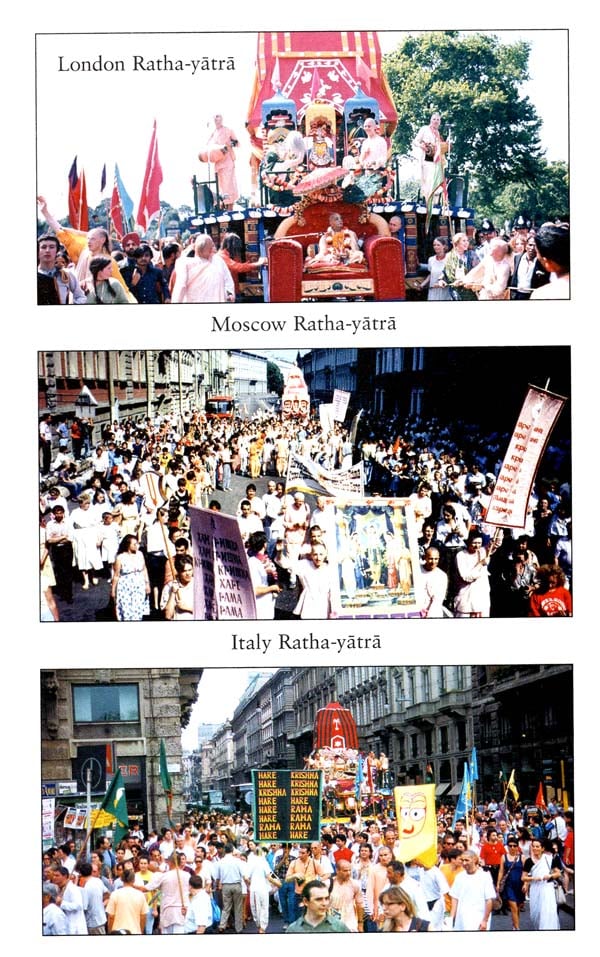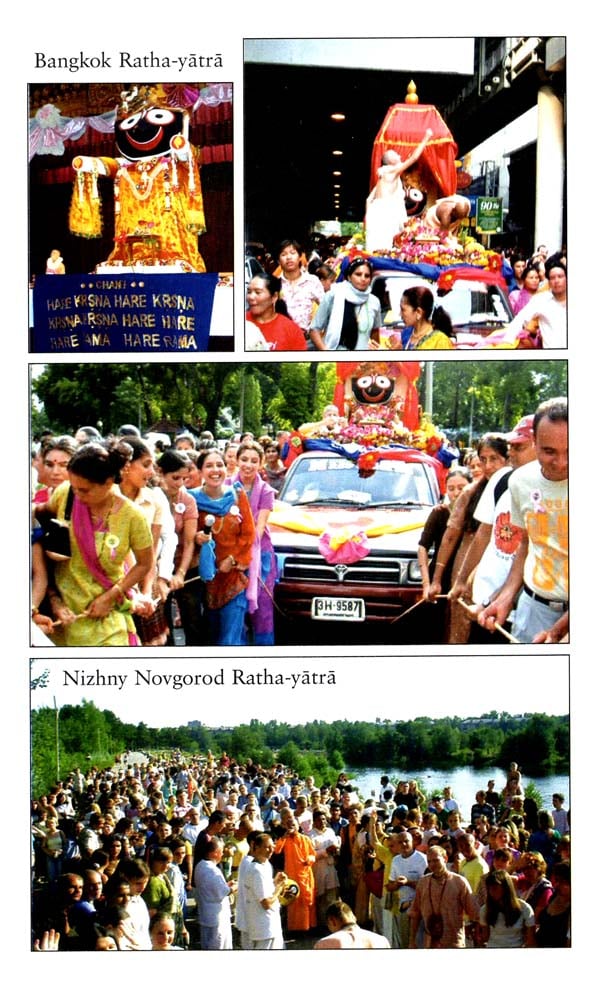
The Drama of Lord Jagannatha (Jagannatha- Priya Natakam)
Book Specification
| Item Code: | NAU897 |
| Author: | Tamal Krishna Goswami |
| Publisher: | The Bhaktivedanta Book Trust |
| Language: | English |
| Edition: | 2012 |
| ISBN: | 9789382176664 |
| Pages: | 120 (Throughout Colored and 7 B/W Illustration) |
| Cover: | PAPERBACK |
| Other Details | 9.00 X 6.00 inch |
| Weight | 160 gm |
Book Description
Each year the splendidly decorated chariots of Jagannatha, the Lord of the universe, roll down the avenues of dozens of Cities around the world—including Los Angeles, New York, Washington, Auckland, Calcutta, Paris and London. Their towering red-and- blue silken canopies rise into the sky as drums and cymbals resound in joyous celebration. People young and old, their eyes bright with excitement, sing and dance in the street, as if swimming in an ocean of overwhelming happiness. The Ratha-yatra Festival, new to nations outside India, is perhaps the oldest continuously celebrated spiritual festival in the world. As far back as human records and memory extend, the chariots of Lord Jagannatha have rolled each summer in the town of Puri on the Bay of Bengal, to the delight of millions of joyous pilgrims.
Throughout the year, the Deity of Jagannatha is worshiped in a great temple, the massive stone tower of which dominates the city of Puri. The Deity is not a mere statue. By His supreme potency, the Supreme Lord agrees to personally enter the form of the Deity, just to accept the loving service of His devotees. In this sense the Deity is non-different from the Lord Himself. And once a year Lord Jagannatha comes forth in all His magnificent splendour to enjoy the Ratha-yatra parade and show Himself to all.
The story of how this particular Deity came to be installed in the great temple of Puri is quite intriguing. Many thousands of years ago, a king named Indradyumna desired to have some- one carve special Deity forms of Lord Krsna and His brother Balarama and sister Subhadra. Visvakarma, an architect and artist from the heavenly planets, agreed to make the Deities on the condition that no one would interrupt his work. The King agreed to this proposal, and Visvakarma set about carving the Deities, working in a locked room. Once, however, the King, impatient with the slow pace of the work, entered the room to see how much progress had been made. At that instant, Vis- vakarma vanished, leaving three incompletely carved forms. The king, however, was so pleased that he installed them in a great temple and worshiped them with great opulence. Each year, he arranged a grand procession, during which each of the three Deities rode on a large beautifully decorated cart.
Then 500 years ago, the festival became the center, of the pastimes of Lord Caitanya, who is Krsna Himself appearing in the guise of a great devotee of the Lord. Each year Lord Caitanya danced and chanted in the Ratha-yatrd festival along with His associates. To this day, the followers of Lord Caitanya eagerly participate in the chariot procession in Puri and others like it held throughout India, and the Vedic scriptures state that anyone who sees Lord Jagannatha or pulls His chariot achieves immense spiritual benefit.
In the early part of this century, a young boy in Calcutta desired to stage a miniature version of the Ratha-ydatra festival in his neighbourhood. His father took him put to purchase a cart, but could not afford the price asked by the local carpenters. On their way home, the boy cried. When an elderly Bengali lady learned the cause for the boy’s tears, she offered the boy and his father an old cart of her own. Accepting the cart, father and son later renovated it, decorating it exactly like the original in the Puri Ratha-yatrd festival. Neighbourhood ladies agreed to cook preparations for a feast, and finally the boy staged his own Ratha-yatrd festival, to the delight of his friends, relatives; and neighbours.
This boy later grew up to be His Divine Grace A.C. Bhaktivedanta Swami Prabhupada, founder-dcdrya of the International Society for Krishna Consciousness. Srila Prabhupada,
who brought pure Krishna consciousness to the world outside India for the first time, was eleventh in the line of spiritual masters in succession from Lord Caitanya. During a whirlwind of missionary activity in the last 12 years of his life, from 1965 to 1977, he journeyed to America and then traveled repeatedly around the globe, igniting a world-wide spiritual revolution that continues to expand. Srila Prabhupada founded over a hundred temples, wrote dozens of books, initiated thousands of disciples. And along with everything else, he introduced the Ratha-ydtra. festival he loved so much.
Srila Prabhupada selected San Francisco as the first site in the West for the annual Ratha-yatra Day celebration and in- structed his disciples: "You must arrange a procession down the main street. Do it nicely. They have such & procession yearly in Jagannatha Puri." The first procession was simple: the Deities of Lord Jagannatha, Lord Balarama, and Lady Subhadra were taken through the streets of the Haight-Ashbury district on a small flatbed truck, to the accompaniment of chanting and dancing.
DIRECTOR.
Good evening, saintly Vaisnavas, Having come from far and near To behold Caitanya-candra’s Quincentennial this year. * May we bid you all warm welcome To the theater we’ve now formed So your hearts can all be brightened And enlightened and reformed. No frivolous amusements here, Prepared in careless haste, Which so commonly offend All those of culture and good taste; No tragic endings dramatized That sober men would cry.
When they see their fav’rite heroes Cruelly crushed by Fate to die. As spring’s green buds unfold and bloom, Awak’ning hearts’ fresh hope, May this drama of devotion Sanctify your vision’s scope. Please entwine your bhakti creepers In the tamala desire tree; Jagannatha-priya Natakam Commences presently.
Here. Let me bring my assistant. [He calls a female assistant by name]
ASSISTANT [Entering]. Master, I am ready, but I fear the others are not.
DIRECTOR. After so many months of rehearsal you still lack confidence?
ASSISTANT. This drama is totally different from those per- formed in the past. The parts are extraordinarily demanding and strain the limits of our memory. And there is no scenery to help create the mood. The directions call for unusually skillful expression and movement. In short, we hesitate to attempt such a daring drama when [motioning to the audience] all the eyes of the world are upon us.
DIRECTOR. Would you have us disappoint such exalted personalities after I have whetted their appetite? It was precisely for their pleasure that this drama was composed, for who but these devoted souls can fully relish the spiritual sentiments that are the very essence of this play? Undisturbed in mind, with senses fully alert, they can appreciate the care taken in con- structing the plot, developing the characters, and portraying the subtleties of rasa.
ASSISTANT. But could they not have been equally satisfied by hearing a recitation of our holy scriptures?
DIRECTOR, True enough, there is no higher satisfaction. And yet the art of drama has its special place as well. It is for this reason that our great dcdrya, Srila Rapa Gosvami, has written an elaborate commentary known as Nataka-candrikd, elucidating the laws of drama first set forth in the Natya-sastra of the sage Bharata. The drama we are to perform today adheres to Srila Rapa Gosvami’s injunctions. And bear in mind the statement of ISKCON’s founder-dcdarya, Srila Prabhupada, who predicted: "Krsna consciousness will be established by cultural conquest."
ASSISTANT. This is inspiring! Your words fortify me.
DIRECTOR. Then kindly begin to satisfy these saintly Vaisnavas, who, like thirsty cakora birds with their necks stretched high, eagerly await the cloudburst of Krsna’s pastimes. Like Indra, let loose your lightning bolt and emblazon the sky of our consciousness, and let the shower of your nectarean words slake our thirst. May the blessings of the assembled Vaisnavas be our crown of success, bowed low before the lotus feet of His Divine Grace Srila Prabhupada.
ASSISTANT. [Gesturing to the audience] The earth’s rivers are rich with jewels, Her mountains lush with plants, The six seasons and heaven’s orbs Perform a rhythmic dance. A thousand centuries men live, And those are free of fear, Satya-yuga’s blessed force Prevails both far and near. Saint and king combine as one, For goodness is the norm; The sun’s race has reached its crest, Indradyumna has been born.
Mercy, courage, steadfastness Each trait a glowing gem Adorn the king, who, like the Lord, Subdues demonic men. Brilliantly bedecked, He puts other kings to shame The monarch of Avantipura, Indradyumna, all acclaim!
DIRECTOR. There’s no doubt about what you’ve said. With his enemies subdued and his citizens so loyal, King In- dradyumna is indeed like a blazing ray of Sarya. But at times even the sun is covered by clouds, and so also, it now seems, is the king’s unwavering disposition. Lately he shows little interest in his usual duties.
VIDYAPATI [From behind the scenes]. Hey! Has this rumor become so common that it is batted about in public?
DIRECTOR. That must be Vidydpati, the head priest. Come! Let’s hear what he is saying.

